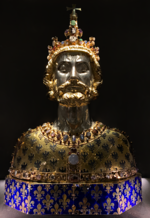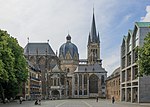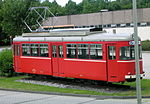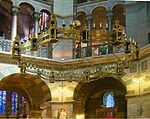Aachen thermal springs
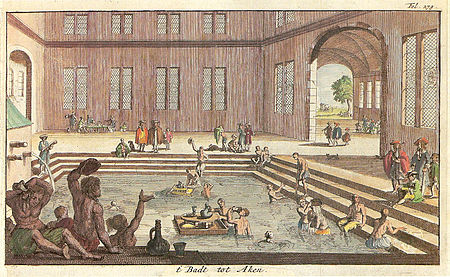
The Aachener Thermalquellen, also known as the Thermal Springs of Aachen and Burtscheid, are a system of more than 30 thermal mineral springs located in the area around Aachen (Aix-la-Chapelle), Germany. The area has been known for its hot sulfur springs for thousands of years. The hot mineral water aquifer flows from the Upper Devonian limestones that meet the Variscan thrust front of the Rhenish Massif, and flow through the city center of Aachen in a 500m long by 50m (maximum width), that emerges from the source at numerous spring heads. Four of these spring heads are still accessible; two are managed. The hot spring flow from Burtscheid (a district of Aachen) is 2200m long with numerous spring heads. The hot springs have been used for balneotheraputic purposes since the early Roman settlement in Aachen. The historical political and economic growth of Aachen developed around the springs, in particular mineral water production, the spa and bathing sector, and the textile industry. Later the Franks arrived. The first known written text about Bad Aachen (Aachen baths) is linked to the Frankish king, Pippin the Short. Charlemagne inherited Pippin's manor at Bad Aachen sometime after 766 AD.Aachen came to be known as an elegant European spa town where personages such as George Frideric Handel, Albrecht Dürer, Voltaire, and Peter the Great "took the waters” at Bad Aachen.
Excerpt from the Wikipedia article Aachen thermal springs (License: CC BY-SA 3.0, Authors, Images).Aachen thermal springs
Ritter-Chorus-Straße, Aachen Burtscheid (Aachen-Mitte)
Geographical coordinates (GPS) Address Nearby Places Show on map
Geographical coordinates (GPS)
| Latitude | Longitude |
|---|---|
| N 50.775555555556 ° | E 6.0836111111111 ° |
Address
Katschhof
Ritter-Chorus-Straße
52062 Aachen, Burtscheid (Aachen-Mitte)
North Rhine-Westphalia, Germany
Open on Google Maps




